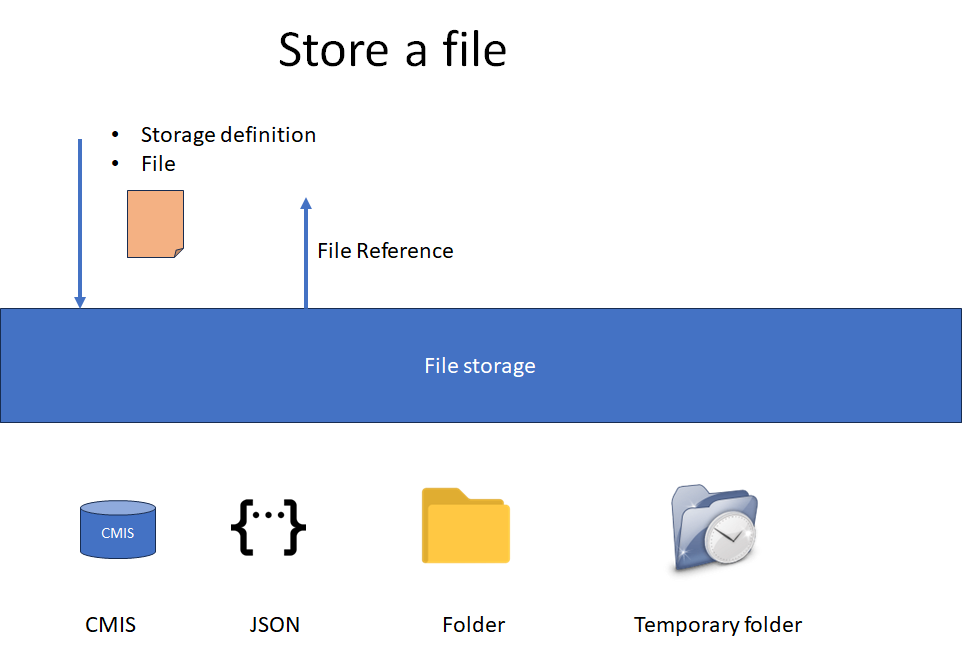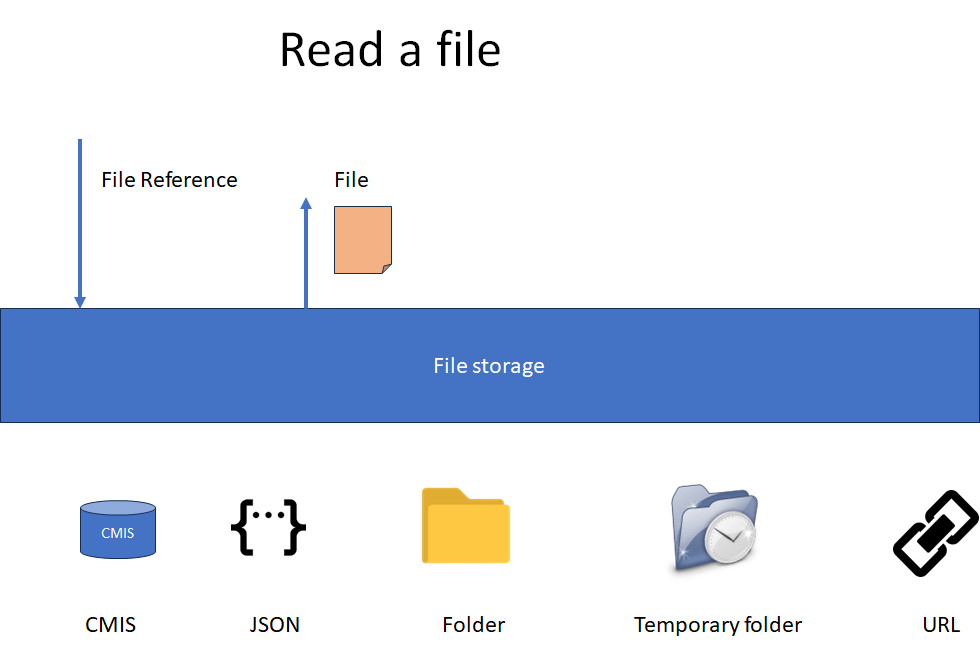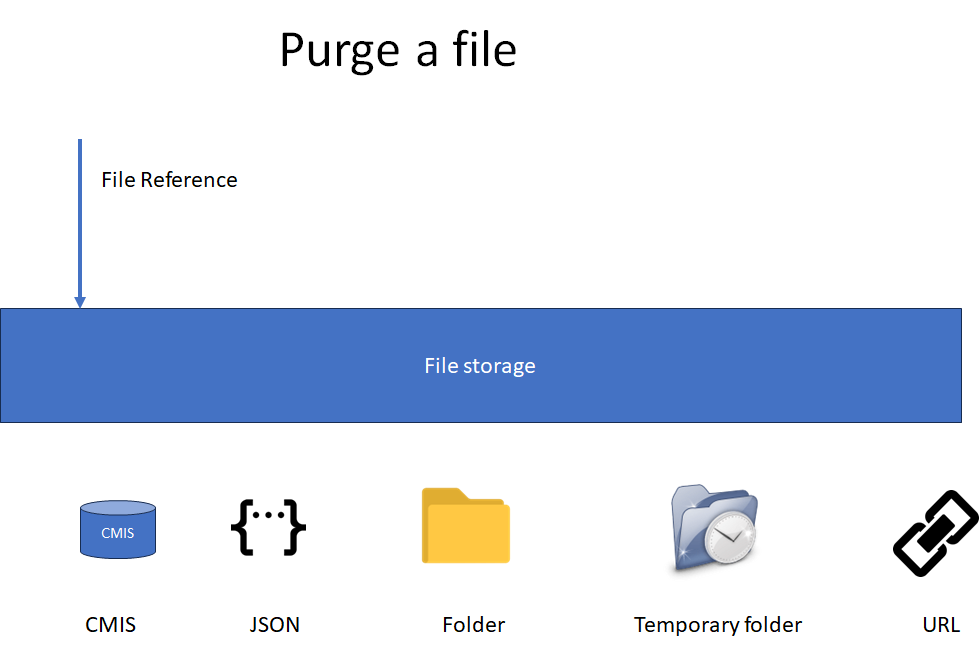Library to manipulate File process variables and store the content in different storage (Folder, CMIS...)
This library is used by connectors or by an application.
Zeebe can't manipulate the files, only String as a process variable.
The idea is to give to the File Storage the file and get back a File Reference. The File Reference can be saved as a process variable.
Multiple storage are available: to specify which file storage is used, a Storage Definition is provided.

Multiple storages are available (see the section below).
- CMIS: Any Content Management Interoperability Services. A lot of tools exist.
- JSON: the file is saved directly in the file reference. Zeebe allows only 4 Mb for the payload; this method works only for small files.
- Folder: a folder on the host. Specify a shared folder in the cluster
- Temporary Folder: the temporary folder of the host is used (assuming all applications/connectors/workers run on the same host)
With the File Reference*, it is possible to retrieve the file
Note: The storage "URL" can be used to read a file from a URL. It is a Read Only storage.
The file can be purged from the storage when the process is finished. The File Reference is provided.
There is no "expiration mechanism" (except the temporary folder, which is purged on each reboot), so the application must purge files.
The API contains three main access.
Get an instance of the factory.
FileRepoFactory fileRepoFactory = FileRepoFactory.getInstance();Create a FileVariable. Upload the file in the FileVariable object.
FileVariable fileVariable = new FileVariable();
byte[] contentInByte = <Content In Byte>
fileVariable.setValue( contentInByte );
fileVariable.setName( "MyDocumentName.pdf");
fileVariable.setMimeType( FileVariable.getMimeTypeFromName(fileVariable.getName()));Set the Storage Definition. The Storage Definition describes where the core document is stored.
StorageDefinition storageDefinition = StorageDefinition.getFromString(storageDefinitionSt);
fileVariable.setStorageDefinition(storageDefinition);See below the different Storage definitions available, and the structure of the storageDefinitionSt.
Save the File Variable. The function returns a FileVariableReference.
FileVariableReference fileVariableReference = fileRepoFactory.saveFileVariable(fileVariableValue);The fileVariableReference is only a reference and can be saved in the process variable.
String processVariableSt = fileVariableReference.toJson();
// save the processVariableSt as a process variableAccess the file from the FileVariableReference.
String processVariableSt = <GetFromProcessVariable>
FileVariableReference fileVariableReference = FileVariableReference.fromJson( processVariableSt );Then, get the FileVariable from the repository.
FileRepoFactory fileRepoFactory = FileRepoFactory.getInstance();
FileVariable fileVariable = fileRepoFactory.loadFileVariable(fileVariableReference);Content, fileName, and MimeType are available via the method.
The Storage Definition information is saved in the FileVariable to update it, change the content, and store it again.
From the FileVariableReference, purging the document in the storage is possible.
String processVariableSt = <GetFromProcessVariable>
FileVariableReference fileVariableReference = FileVariableReference.fromJson( processVariableSt );
FileRepoFactory fileRepoFactory = FileRepoFactory.getInstance();
boolean filePurged = fileRepoFactory.purgeFileVariable(fileVariableReference);Different Storage Definition* are available. The storage stores the core of the document.
The file is saved in JSON, and the FileVariableReference contains the complete document. It is very efficient, but Zeebe limited the size of the process to 4 Mb. This solution does not make it possible to save documents (Word, OpenOffice, PDF) which are in general bigger.
Storage Definition Key: "JSON"
import StorageJSON;
String storageDefinition = StorageJSON.getStorageDefinitionString();The file is saved in the Temporary folder of the host. If multiple applications (different connectors) need to access the file, this is not an acceptable document, except if all applications are hosted by the same machine (or the same Pod)
Storage Definition Key: "TEMPFOLDER"
import StorageTempFolder;
String storageDefinition = StorageTempFolder.getStorageDefinitionString();The file is saved in the folder given in the connection string. If multiple applications need to access the file, the folder must be visible and shared in the same place (/mnt/file storage" for example).
Storage Definition Key: "FOLDER:/this/is/the/path/to/the/storage"
import StorageFolder;
String storageDefinition = StorageFolder.getStorageDefinitionString(String folder);The file is saved in a CMIS tool. The connection to the tool (URL, Repository name, username, password) must be provided. The folder where the file must be stored must be provided, too.
Storage Definition Key: "CMIS:{"url":"", "repositoryName":"", "userName": "", "password": "", "storageDefinitionFolder":""}"
The static method is available in the StorageCMIS class.
import StorageCMIS;
String storageDefinition = StorageCMIS.getStorageDefinitionString(String url, String repositoryName, String userName, String password, String storageDefinitionFolder)The file may be accessed via a URL. This storage is used to READ only.
For example, this source file reads a document from a URL.
import StorageURL;
String storageDefinition = StorageURL.getStorageDefinitionString("https://github.com/camunda-community-hub/camunda-8-connector-officetopdf/raw/main/src/test/resources/OfficeToPdfExample.docx");This method return a Storage definition from a String
import StorageDefinition;
StorageDefinition storageDefinition = StorageDefinition.getFromString( storageDefinitionSt );The format of the string is the following: :
Types are JSON, TEMPFOLDER, FOLDER, CMIS, URL
Complement depends of the type.
JSON, TEMPFOLDER, URL does not have any complement.
CMIS contains as reference the access information, saved in JSON, for example
"CMIS:{\"url\":\"http://localhost:8099/lightweightcmis/browser\",\"userName\":\"cmisaccess\",\"password\":\"demo\",\"storageDefinitionFolder\":\"/storagecmis\"}"
FOLDER needs to describe the folder
"FOLDER:/this/is/the/path/to/the/storage"
From a StorageDefinition, the string can be get:
String storageDefinitionSt = storageDefinition.encodeToString()


